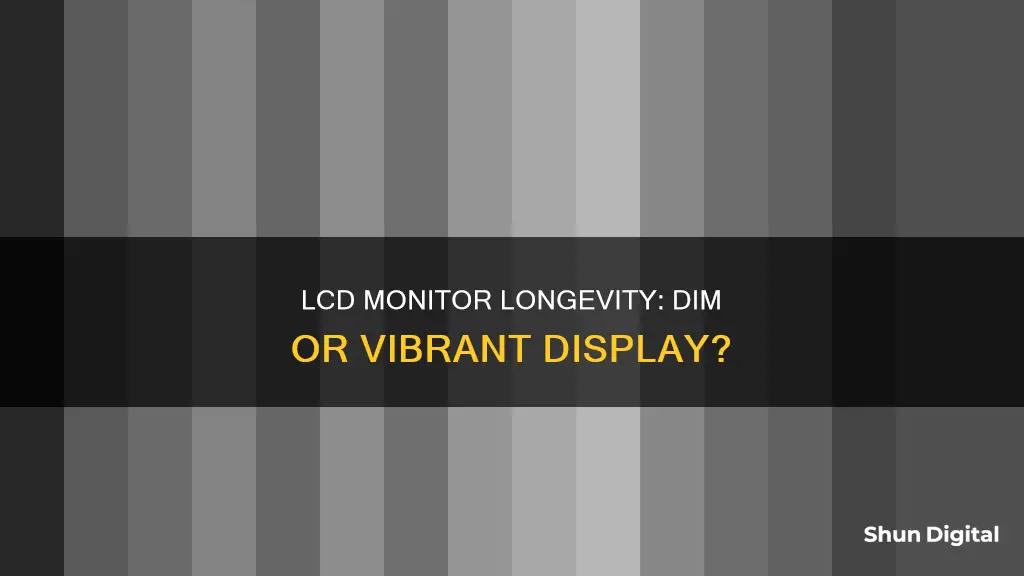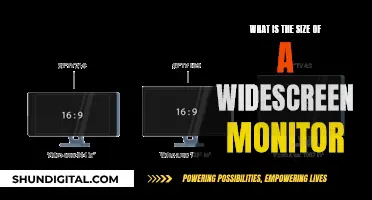
LCD monitors do not produce their own light, instead relying on a backlight to illuminate the screen. The brightness of an LCD monitor can decrease over time, but this is due to the backlight dimming, not the LCD itself. CCFL backlights, which were common in older LCD monitors, degrade and dim over time, while LED backlights, which are more common in modern LCD monitors, slowly dim over time as they approach their half-life. However, the dimming process for both types of backlights is fairly slow, so unless the monitor is left on 24/7 for a long period, you are unlikely to notice a significant decrease in brightness.
| Characteristics | Values |
|---|---|
| Do LCD monitors dim over time? | Yes, but very slowly. |
| What causes the dimming? | The CCFL backlights in the monitors degrade over time. |
| How to slow down the dimming? | Avoid excessive current, excessive heat, and vibration. |
| How to improve brightness? | Replace the transflective polarizer with a transmissive polarizer. |
| How long do LCD monitors last? | On average, LCD monitors last for 20,000 hours, or about 2 years if used 24/7. |
What You'll Learn

CCFL backlights in monitors degrade over time
CCFL backlights in monitors will degrade and dim over time. CCFL stands for cold cathode fluorescent lamp, and these lamps were the backlight of choice for most early iterations of the consumer LCD. The CCFL is a hollow glass tube filled with reactive mercury gas and sealed with electrodes.
CCFLs have a relatively simplistic design, and so they are cheap and durable. They are also easily scalable, which means they can be miniaturized for smaller and cheaper electronic devices. CCFLs produce an even, smooth light, which can be distributed behind an LCD screen for optimal colour and contrast.
However, CCFLs require a high voltage to reach peak luminance, and this can cause increased heat, which may lead to degradation over time and a shorter component lifespan. The high voltage can also be a health hazard, as the mercury gas inside is dangerous to humans, especially the lungs. As CCFL lamps age, they require more voltage to stay lit, which puts a strain on the inverter that powers the lamp. This can lead to a costly repair.
The typical rated life of a CCFL backlight is 20,000 to 40,000 hours, or between one and three years of use.
Battery Size for Elfi Doggy Monitor: All You Need to Know
You may want to see also

LCDs don't illuminate on their own
It is important to note that LCDs (liquid-crystal displays) do not illuminate on their own. They require a backlight to be visible in the dark. Historically, LCDs were backlit by cold cathode fluorescent lamps (CCFLs), but nowadays, most LCD monitors use LEDs (light-emitting diodes).
The backlights in LCD monitors will dim over time, but this process is fairly slow. The CCFL backlights in particular will degrade and become dimmer, but unless the monitor is left on for extended periods, it will take a long time to notice any difference. The LED backlights in LCDs have a half-life, which means that after a certain number of hours, the brightness will be at 50% of what it was originally. For example, if an LED backlight has a half-life of 50,000 hours, it will be at half brightness after this time.
The cathode bulb in an LCD can also dim over time, and the inverter can "wear out", lowering the voltage and causing the screen to dim. However, this usually takes a few years to occur. Additionally, the type of display module in an LCD can affect its brightness over time. Emissive displays produce their own light and can be seen in low-light conditions, whereas non-emissive displays require a backlight to be visible in the dark.
The brightness of an LCD monitor can be affected by several factors, including excessive current, excessive heat, and vibration. These environmental conditions can shorten the life of an LED backlight. To optimise the lifespan of an LED backlight, it is recommended to keep it away from power supplies, high-wattage resistors, and other heat-producing components.
The Origin Story of ASUS Monitors: Where Are They Made?
You may want to see also

The half-life of LED backlights
The lifetime of an LED backlight can be affected by various factors, including excessive current, excessive heat, and vibration. LED backlights are designed to operate at an optimum voltage and current, and increasing the current to make the backlight brighter will reduce its half-life. Extreme temperatures can also lower the half-life and may even cause the backlight to burn out. Therefore, it is important to keep LED backlights away from heat-producing components. Additionally, although LED backlights are solid-state, they are susceptible to heavy vibration, which can reduce their half-life.
To increase the half-life of an LED backlight, measures such as integrating a PWM (pulse width modulation) and dimming the backlight when not in use can be implemented.
It is worth noting that the brighter the LED backlight, the shorter its half-life. This is because the brightness of an LED backlight is determined by the amount of current it is driven at.
Monitors for RX470: Size and Compatibility Limits
You may want to see also

LCD monitors with CCFL backlighting
CCFL backlights degrade and dim over time, although this process is fairly slow and will not be noticeable unless the monitors are left on for extended periods of time. The dimming occurs due to the light-emitting qualities of the CCFL element degrading with use and age. This is one of the reasons that LED backlights are now more commonly used than CCFL.
CCFL backlights have some advantages over LED backlights. They produce a more even light, especially over larger displays, and they do not need to be dimmed in sunlight to avoid glare. CCFL backlights also generally produce less heat than LED backlights, although this is becoming less true as LED technology improves.
However, there are several disadvantages to CCFL backlighting. CCFL backlights have a shorter lifespan than LED, usually estimated at 20,000 to 30,000 hours, and they require a higher voltage and an inverter to function. CCFL backlights also contain mercury, which is why many countries are limiting or banning their use.
Unlocking ASUS Monitor: Opening OSD Settings
You may want to see also

LED-lit LCD monitors are thinner and lighter
LCD monitors have been around for a while, and they have evolved over time. Initially, most LCDs were backlit with cold cathode fluorescent lamps (CCFLs). Now, most modern LCD monitors are lit with LEDs.
LED-lit LCD monitors are thinner, lighter, and use less power than their CCFL predecessors. They are also more energy-efficient, with a longer lifespan, and offer better colour accuracy and contrast ratios. The thinness of the screens is especially notable in edge-lit panels, which can be less than 0.5 inches (13 mm) thin. They are also significantly lighter, weighing as little as half of a comparable CCFL monitor.
The advantages of LED-lit LCDs over CCFL-LCDs are due to the backlighting technology. LED-lit LCDs use light-emitting diodes (LEDs) for backlighting, which are very small bulbs. The arrangement of these LEDs varies, with full-array LED backlighting or edge lighting. Full-array lighting has diodes evenly distributed behind the monitor, providing even lighting across the screen. Edge lighting places the LEDs around the perimeter of the monitor, with light spread using a sheet of plastic. This method is cheaper to manufacture but can result in less uniform lighting.
The use of LEDs for backlighting offers a wider colour gamut and dimming range, as well as a greater contrast ratio. LED-lit LCDs also have a longer lifespan, with LED backlights lasting 50,000 to 100,000 hours compared to 30,000 to 60,000 hours for CCFL backlights. This extended lifespan, along with the other benefits of LED-lit LCDs, makes them a superior choice for gaming, graphic design, and video editing.
Asus Monitor Bluetooth: Is It Built-In or Not?
You may want to see also
Frequently asked questions
LCD monitors do not produce their own light and depend on a backlight to be seen in low-light conditions. The backlight can be either a CCFL bulb or a set of LEDs. CCFL bulbs will degrade and dim over time, but this process is fairly slow, so the monitor will need to be left on for a long time before any dimming is noticeable. LEDs will also dim over time, but they have a longer lifespan than CCFL bulbs.
You are unlikely to notice any dimming unless you compare your old monitor to a new one side by side.
You can prevent dimming by reducing the brightness settings on your monitor.







